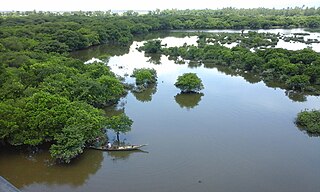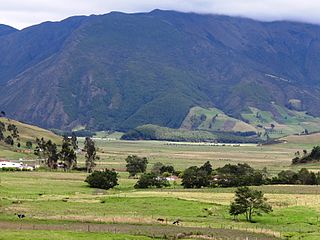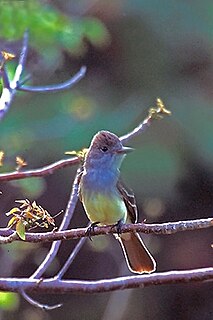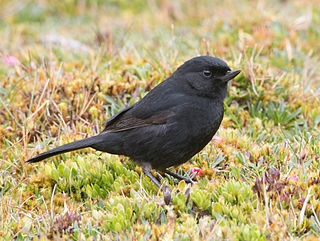
El Burro is a wetland, part of the Wetlands of Bogotá, in the locality Kennedy, Bogotá, Colombia. The wetland on the Bogotá savanna covers about 19 hectares and is crossed by the Avenida Ciudad de Cali.

Techo is a neighbourhood (barrio) of Bogotá, Colombia, part of the locality Kennedy. It contains a wetland of the same name, part of the Wetlands of Bogotá, Colombia. The wetland covers about 11 hectares.

Capellanía is a wetland situated in the locality of Fontibón as one of the Wetlands of Bogotá, Colombia. It forms part of the Fucha River basin on the Bogotá savanna. Since 1995, it has been split into two due to the construction of the Avenida La Esperanza. This has caused rapid deterioration and the wetland is likely to disappear because of the industries that surround it, the current transportation projects of the area, and future developments approved by the district. The wetland covers 27 hectares.

Córdoba is a wetland, part of the Wetlands of Bogotá in Bogotá, Colombia. It is situated on the Bogotá savanna in the locality Suba between the Avenida Boyacá and Avenida Córdoba and the streets Calle 127 and Calle 116, close to the TransMilenio stations Shaio and namesake station Humedal Córdoba. The wetland covers about 40 hectares.

Jaboque is a wetland, part of the Wetlands of Bogotá, located in the locality Engativá, Bogotá, Colombia. The wetland, close to the Bogotá River on the Bogotá savanna covers an area of 148 hectares. The wetland is close to El Dorado International Airport in the Juan Amarillo River basin.

La Vaca or Techovita is a small wetland, part of the Wetlands of Bogotá, located in the locality Kennedy, Bogotá, Colombia. The wetland, in the Tunjuelo River basin on the Bogotá savanna covers an area of about 8 hectares. La Vaca is close to the Avenidad Ciudad de Cali.

La Conejera is a wetland, part of the Wetlands of Bogotá, located in the locality Suba, Bogotá, Colombia. The wetland, in the Juan Amarillo River basin on the Bogotá savanna covers an area of 58.9 hectares.
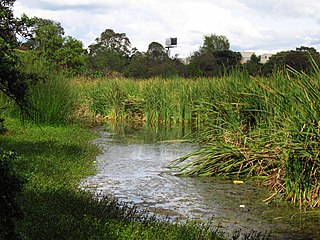
Santa María del Lago is a wetland, part of the Wetlands of Bogotá, located in the locality Engativá, Bogotá, Colombia. The wetland on the Bogotá savanna covers an area of 12 hectares, of which 4 hectares water.
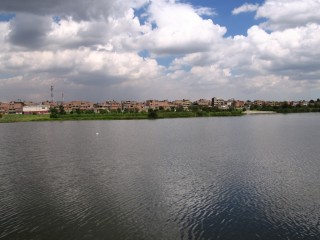
Tibabuyes or Juan Amarillo Wetland is a wetland, part of the Wetlands of Bogotá, located in the localities Suba and Engativá, Bogotá, Colombia. The wetland, in the Juan Amarillo River basin on the Bogotá savanna is the largest of the wetlands of Bogotá and covers an area of 222 hectares.

The Fucha River is a river on the Bogotá savanna and a left tributary of the Bogotá River. The river originates in the Eastern Hills of the Colombian capital Bogotá and flows westward through the city into the Bogotá River. It is one of the three important rivers of the city, together with the Tunjuelo and Juan Amarillo Rivers.

Tibanica is a wetland, part of the Wetlands of Bogotá, located on the border of the locality Bosa, Bogotá and Soacha, Cundinamarca, Colombia. The wetland on the Bogotá savanna covers an area of about 28.8 hectares. Tibanica is located in the Tunjuelo River basin.

El Salitre is a small wetland, one of the wetlands of Bogotá. It is located within Salitre Park, close to Salitre Mágico, an amusement park north of Simón Bolívar Park in the locality Barrios Unidos of the Colombian capital Bogotá. The area of El Salitre is 6.4 hectares.

La Isla is a small wetland, part of the wetlands of Bogotá. It is located next to the Tunjuelo River in the locality Bosa, Bogotá, Colombia. The Bogotá River passes 800 metres (2,600 ft) south of the wetland with an area of 7.7 hectares.

Meandro del Say is a wetland, part of the wetlands of Bogotá. It spans the locality Fontibón of Bogotá and the eastern part of Mosquera, Cundinamarca. Meandro del Say is located close to the Bogotá River with a total area of 13.6 hectares. The Avenida Centenario borders the wetland in the northeast. Meandro de Say is situated in the Fucha River basin.

La Florida is a wetland and park known as the Parque Metropolitano La Florida. La Florida is located across the Bogotá River from Jaboque wetland in the municipality Funza, Cundinamarca, close to Cota. La Florida does not belong to the protected wetlands of Bogotá.

Guaymaral y Torca is a combined wetland, part of the Wetlands of Bogotá, located in the north of the Colombian capital in the localities Suba and Usaquén, Bogotá, Colombia. The wetlands on the Bogotá savanna cover an area of about 73 hectares. Guaymaral y Torca, the northernmost wetlands of Bogotá at the foot of the Eastern Hills, is composed of three parts, Guaymaral in the west in Suba, Torca in the east in Usaquén and a small strip along the dividing Autopista Norte between the two main wetlands. The wetlands are located in the Torca River basin. The Autopista Norte was constructed in 1952, dividing the wetlands.

The Juan Amarillo, Arzobispo, or Salitre River is a river on the Bogotá savanna and a left tributary of the Bogotá River in Colombia. The river originates from various quebradas in the Eastern Hills and flows into the Bogotá River at the largest of the wetlands of Bogotá, Tibabuyes, also called Juan Amarillo Wetland. The total surface area of the Juan Amarillo basin, covering the localities Usaquén, Chapinero, Santa Fe, Suba, Barrios Unidos, Teusaquillo, and Engativá, is 12,892 hectares. Together with the Fucha and Tunjuelo Rivers, the Juan Amarillo River forms part of the left tributaries of the Bogotá River in the Colombian capital.

The Torca River is a river on the Bogotá savanna and a left tributary of the Bogotá River. The river, in a basin of 6,008.69 hectares (23.1997 sq mi), originates in the Eastern Hills of Bogotá at an altitude of 2,837 metres (9,308 ft). It flows in the north of the Colombian capital, through the locality of Usaquén and into the Bogotá River in Suba at the border with Chía, at 2,545 metres (8,350 ft) above sea level. The Torca wetland is located near its mouth.

